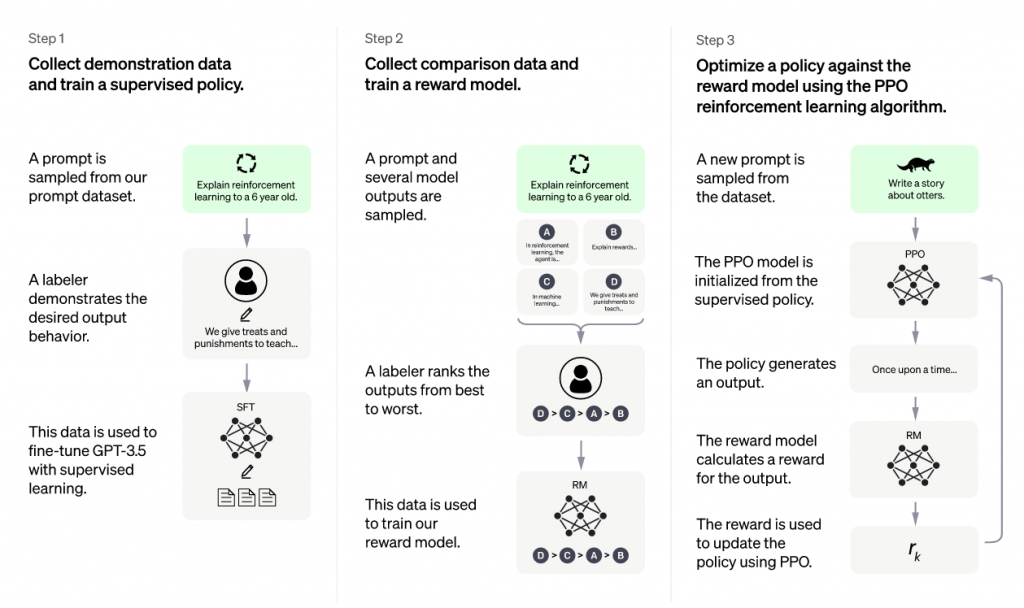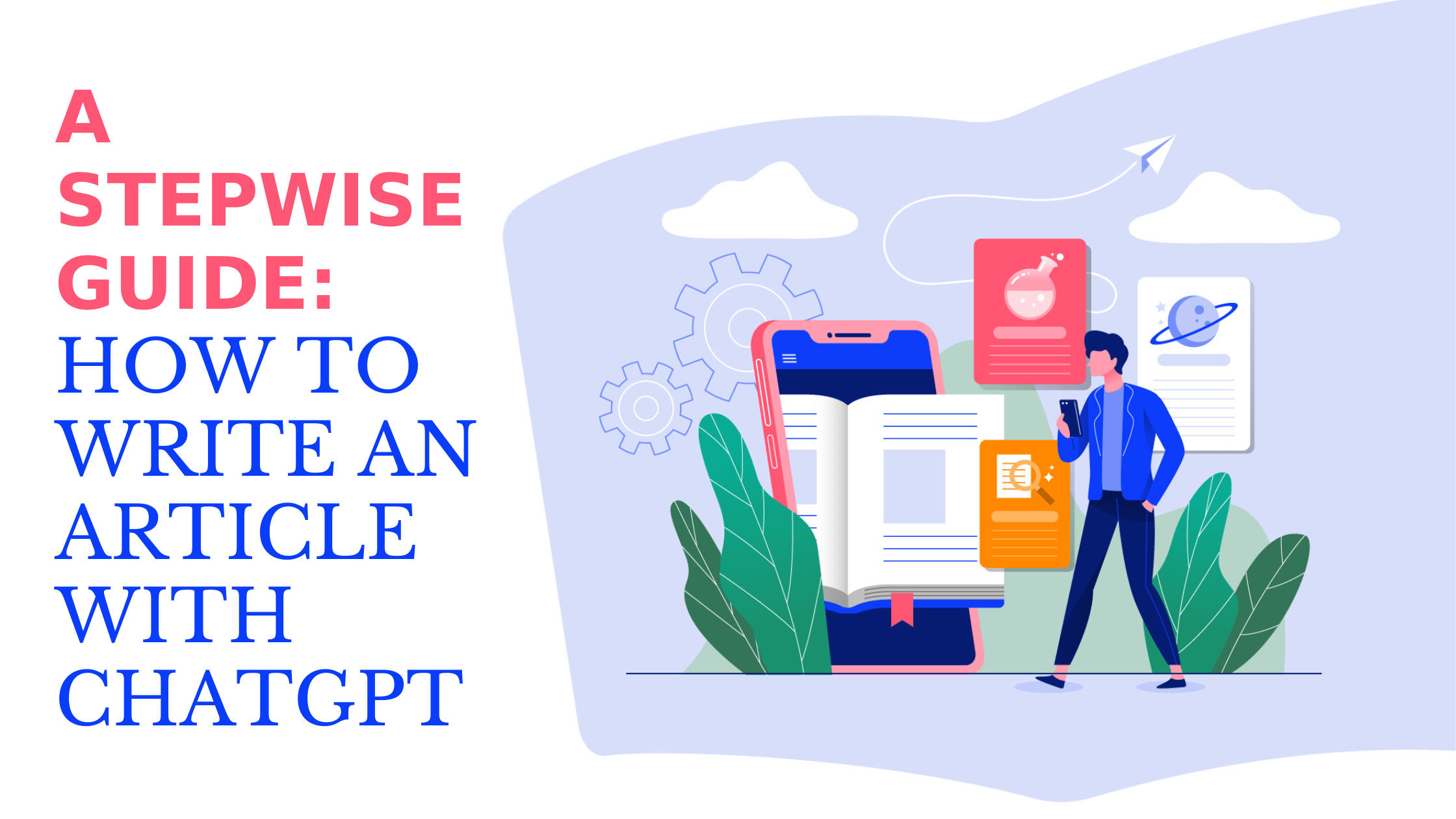In the previous blog, we have already discussed ChatGPT and how ChatGPT can help small businesses. Now, in this blog, I’ll show a practical approach to how you can use Chat GPT to generate content and thus help your small businesses to grow.
In this blog, I will talk about ChatGPT — the recent release from OpenAI, the creators of the (in)famous DALL·E. How does Chat GPT work? How to write a blog with ChatGPT? Will this algorithm eventually replace skilled bloggers? Let us explore. We tried using ChatGPT to write a post for our blog, and this is what we came up with.
Let’s begin.
HOW DOES CHATGPT WORK?
The ChatGPT algorithm was designed mostly for verbal conversations, the learning process consisted of three stages:
Supervised learning — AI (Artificial Intelligence) specialists provide samples of human-written outputs that look like a conversation between two people.
Training a reward model — Artificial intelligence specialists (humans) provide prompts, receive outputs, rank them, and feed this ranking data into the algorithm.
Optimization — the neural network receives an unfamiliar prompt that wasn’t in the data set before. As the reward model predicts user ratings, the generative algorithm adjusts to improve the next time it is run.

Because ChatGPT is just GPT-3 (Generative Pre-Trained Transformer 3) that has been complemented with human feedback. When compared to GPT-3 AI systems created exclusively for copywriting, this learning strategy is claimed to boost output. Does this imply that ChatGPT should perform better? Let us explore.
HOW TO WRITE A BLOG USING CHATGPT?
During the planning phase of writing this blog, the main goal was to deal with three key issues:
Choosing a topic that is simple to analyze and difficult enough at the same time, to put the generative algorithm through rigorous testing.
Matching the writing process to ChatGPT’s conversational dynamics – because it’s a chatbot, I should hold a conversation with it.
Develop assessment criteria, ideally quantitative, so that I may objectively assess the generative algorithm copywriting abilities of ChatGPT.
Let’s take a deeper look at how I dealt with these issues.
Choosing the topic
The most difficult part was choosing a topic for drafting the article with ChatGPT. I had the following choice criteria:
Broad topic-The topic should not be overly particular because ChatGPT cannot explain any topic by referring to images, identifying email samples, or referring to other articles.
Simplicity – the topic should be simple enough to fact verify
Complexity – although this contradicts the earlier criterion, the article topic should be complex enough to put the generative algorithm of ChatGPT to the test.
We ended up choosing the SEO (Search Engine Optimization) brief about the top 10 ways to promote my app.
Developing the writing method
ChatGPT has two significant limitations: it can only produce 1000 symbols at a time, and it is a conversational model. It means:
We can’t create an entire article with the help of ChatGPT in one sitting.
We must change the workflow to accommodate the conversation’s mechanics.
Developing evaluation criteria
To keep the research at least resembling an actual scientific one, I needed to keep the output evaluation criteria as measurable as possible. Here’s what I came up with:
Style: The Flesch index readability checker on Google Docs.
Uniqueness: using the online plagiarism checker.
Grammar & Spelling: the grammar checking tools and Google Docs spell checkers.
Coherence: Because there is no method to quantify this quality, the criticism of it will be subjective.
Factuality: checked by manual proofreading & fact-checking.
WRITING BLOG WITH THE HELP OF CHATGPT: THE Result
ChatGPT is the answer to all your questions, but the underlying challenge is to frame a correct question (correct prompt). Your prompt must be brief as well mush has keywords that ChatGPT can easily find in its database and generate blogging content accordingly.
For this blog, I want to tell my audience about the top 10 ways to promote my app, which is a general topic. However, if you want to be more specific you can also add other keywords to it like: top 10 ways to promote my app for free/ in 2023/ for iOS apps/ for Android apps, and so on.
For example, I asked ChatGPT the prompt: I have created an app. Tell me the top 10 ways to promote my app. Checkout, the response I got:

This is a great start but there are other important points to remember as well. You shouldn’t just ask ChatGPT to write down the entire blog article for you as its output can’t be longer than 1000 symbols at a time and it’s a conversational model. Rather, you can ask ChatGPT to give you a blog outline, introduction, keywords and key phrases, and supporting statistics for your blog.
When I asked ChatGPT to provide me a blog outline about the top 10 ways to promote my app blog, it responded something like this. If you are not satisfied with the list, you can regenerate your response or add more specifications to your question prompt.


You can also ask for a brief introduction for your blog, or as I have asked for several ideas for the introduction part of my blog.

Depending upon the introduction you liked you can ask more questions about it so that you get a proper introduction for your blog that is generated by AI but sounds human-like.
The next step is keywords, which are incredibly important to optimize your blog. ChatGPT is extremely helpful in this part of content creation. However, as its knowledge base is limited to 2021, so the keywords will be generated as per that year’s trending terms. Keywords must be up to date otherwise they are of no use, so you can support your keyword database with Google search results to get a further refined list of keywords. Also, don’t forget to check the keywords’ ranking and difficulty, for this purpose, you can also take the help of free SEO tools too.



To make your blog more relevant and data-driven, it is always recommended to add research-supported data to your blog so that your blog can be more informative. Chat responded with several statistics, however, the issue is the same the knowledge base is limited to 2021, so I couldn’t get the latest data. This pitfall can be easily overcome by using Google to check if there have been any recent studies to get the latest data.

Further, I also wanted to mention our brand: Swing2App no-code app builder within this blog. So, I asked ChatGPT about it, and it gave me plenty of ideas to incorporate and promote Swin2App within this blog which I found quite great.

KEY POINTS TO NOTE WHEN USING CHATGPT FOR CONTENT GENERATION
1. CHAT GPT CAN ONLY HELP YOU NOT WRITE EVERYTHING FOR YOU
Not only there are instances of an overly complex sentence — the entire paragraph is full of excessive repetitions. A human copywriter would write it in a simple and easy-to-understand manner.
The Flesch readability index gets more than 30/100 when an article is written by AI, which corresponds with “Very hard to read”.
Even if you wanted to publish an article generated by Chat GPT entirely, we wouldn’t publish raw AI output — it requires deep editing, which takes a lot of time.
2. ISSUE OF UNIQUENESS AND PLAGIARISM
I added this criterion for two reasons. Firstly, a blog filled with cheap copy-pasted articles doesn’t fulfill its purpose of educating your audience with something new. Companies need blogs for brand reputation but also for SEO. In addition, Google doesn’t like plagiarized content – you won’t even get to the bottom of the first page. That is why plagiarism checks apply to human copywriters too.
The second reason is a bit more interesting. Sometimes algorithms become a little too well-taught — it’s called overfitting. Overfitting is when a neural network memorizes the training data instead of generalizing it and searching for patterns. In generative neural networks like ChatGPT, this results in copying and pasting input from training sets rather than generating original content. If we put it into perspective, the overfitting problem might be one of the biggest obstacles when it comes to replacing human writers with AI.
The ChatGPT-generated content’s originality index can be above 70%, which corresponds with normal. However, it might be normal for a plagiarism checker, but it doesn’t meet our requirements for human writers.
It doesn’t look like overfitting but if we wanted to publish that article generated by ChatGPT, it would need some rewriting.
3. GRAMMAR & SPELLING ISSUES
ChatGPT-generated content might be full of grammar mistakes or spelling issues. However, according to the detailed review, it’s not as awful as it looks:
Dialect errors: for some reason, the grammar-checking tools might prefer certain words over others, even though the GPT-generated content is totally fine, which is wrong and thus cannot be accounted for as an error.
Typo and Grammar: As ChatGPT generated content based on human inputs stored within it, so if the input has minor typo errors the opt-put will have the same. These errors may be minor like not using hyphens or commas at desired positions.
Excessive word repetition: Excessive repetition of words makes your blog boring to read.
Inconsistency: during the manual proofreading, one might find a lot of alterations between certain variants like eCommerce, and E-Commerce (same word but written differently at various places). It is not a huge mistake but still, not a desirable output.
Although ChatGPT made weird typography choices, in general, the result is not that bad.
The article generated by ChatGPT might need quick proofreading before publication — but on the safer side, ChatGPT didn’t make more mistakes than an average human writer with mild attention issues.
4. COHERENCE IN BLOG
ChatGPT seems to constantly repeat very vague and obvious claims over and over throughout the entire article. If you ask ChatGPT to draft an entire article for you it will be very incoherent and vague. Your readers won’t get Muh information just repetitive things which are stored within Chat GPT.
The lack of coherence is bad but it’s not the fault of the algorithm itself — it’s just the bot’s mechanics being unfit to perform tasks like this.
CONCLUSION
ChatGPT is a wonderful tool for a content writer to lower your burden, however, it is not a full-fledged content writer.
It is unlikely that AI will replace most creative copywriters. Because AI does not understand emotions and empathy, two factors that make good copy, it cannot replace good copywriters.
What is interesting, ChatGPT agrees with me on this matter.
Even though today’s AI cannot replace bloggers, people are still deciding what potential it holds.
One thing is certain: AI is making slow signs of progress, and there will be major advancements in the next years or decades.
